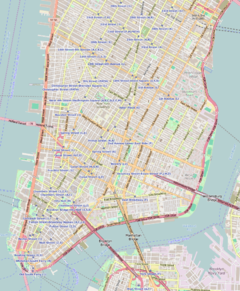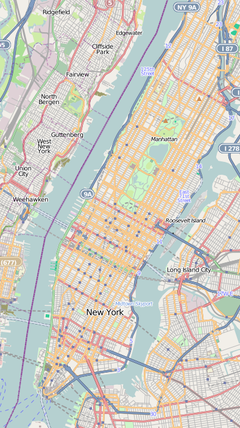70 Pine Street
| 70 Pine Street | |
|---|---|
 | |
| General information | |
| Type | Residential (converted from offices) |
| Architectural style | art deco |
| Location | 70 Pine Street Manhattan, New York City, NY, USA |
| Coordinates | 40°42′23″N 74°00′28″W / 40.70643°N 74.00766°W |
| Construction started | 1930 |
| Completed | 1932 |
| Opening | May 13, 1932[1] |
| Owner | Eastbridge Group (67%), AG Real Estate (33%) |
| Height | |
| Architectural | 952 ft (290 m)[2] |
| Roof | 850 ft (260 m)[3] |
| Top floor | 800 ft (240 m) |
| Technical details | |
| Floor count | 67[2] |
| Floor area | 864,988 sq ft (80,360.0 m2)[4] |
| Lifts/elevators | 24[2] |
| Design and construction | |
| Architect(s) | Clinton and Russell, Holton & George |
| Developer | Rose Associates.[5] |
| Structural engineer | Taylor Fichter Steel Construction |
| Main contractor | James Stuart & Co. Builders |
70 Pine Street – formerly known as the American International Building, 60 Wall Tower and originally as the Cities Service Building – is a 67-story, 952-foot (290 m) residential building[6] located at the corner of Pearl Street and running to Cedar Street in the Financial District of Manhattan, New York City, New York, United States. It was built in 1931–32 by the Cities Service Company[7] for the oil and gas baron Henry Latham Doherty,[8] and was designed by the firm of Clinton & Russell, Holton & George in the Art Deco style.[9]
The building and its first floor interior were designated New York City Landmarks in June 2011.[10] As of 2016, the building is a luxury rental residential property.[11]
History
The Cities Service Building was constructed during the New York skyscraper race, which accounts for its gothic-like spire-topped appearance,[12] a popular architectural style at that time. When completed it was the third-tallest building in the world, after the Empire State Building and the Chrysler Building.[12] It was the last skyscraper to be built in Lower Manhattan prior to World War II, and was the tallest building in Lower Manhattan until the 1970s when the World Trade Center was completed. Upon the September 11 attacks, it regained for some years the status of the tallest downtown building until the completion of the new 4 World Trade Center. It is now the fourth-tallest building in Lower Manhattan. As of 2018, it is the fourteenth-tallest in New York City, and the 25th-tallest in the United States.[2]

One of the most noted themes of the limestone-clad tower is a mountain with a snow cap. The building features an open-air platform with an enclosed glass observatory above it on the 66th floor,[8] offering a higher view of downtown than from any building except from the new World Trade Center. This observatory is no longer accessible to the public. The tower was originally and famously built with double-decker elevators[7] that served two floors at a time to provide sufficient vertical service for the narrow tower and its limited elevator shafts. Soon afterwards, these elevators were removed because of their low popularity;[7] however, the Citigroup Center adopted this same idea in the 1970s.
Cities Service sold the building to the American International Group (AIG) in 1976 [13] when it moved its company headquarters to Tulsa, Oklahoma. It served as AIG's world headquarters until its financial struggles in 2008, and the building was sold to developer Youngwoo & Associates in 2009.[14] The building was later purchased by MetroLoft, which sold it to Rose Associates.[15]
Today, 70 Pine Street is held by Luxembourg-based Eastbridge Group (through DTH Capital), AG Real Estate and Rose Associates, a New York-based developer, owner and operator of premium residential properties.[5] Rose and DTH Capital are in the process of transforming 70 Pine into luxury rental apartments. Residential leasing started in the winter of 2015. Upon completion, 70 Pine will consist of 612 residential units and 132 extended-stay apartments, the later exclusive to Q&A Residential Hotel by Furnished Quarters. In 2016 La Palestra opened at 70 Pine. A 23,000-square-foot high-end fitness centers focused on health and wellness, La Palestra currently offers memberships to building residents and will open to neighborhood residents in 2017.[11] Rose is currently marketing an additional 35,000 square feet of retail space that is accessible from Pine, Pearl, and Cedar streets as well as the building’s lobby.[16]
In November 2016, Justin Casquejo, a thrill-seeking teenage free solo climber and stunt performer, hung from the tower and was charged with misdemeanor base jumping and trespassing for climbing on the tower.[17]
See also
- List of tallest buildings in the United States
- Tallest buildings in New York City
- List of skyscrapers
- World's tallest structures
References
Notes
- ^ Postal, Matthew A. (June 21, 2011) "Sixty Wall Tower" New York City Landmarks Preservation Commission
- ^ a b c d "70 Pine Street" Archived 2015-03-31 at the Wayback Machine on Skyscraper Center website. Accessed: April 13, 2015.
- ^ American International Building at SkyscraperPage.com
- ^ The American International Building, Art Deco Era, part 3, New York Scrapers, greatgridlock.net.
- ^ a b Cuozzo, Steve (August 7, 2012) "Rose Takes Over at 70 Pine St", New York Post
- ^ Yankopolus, Jennifer Evans; Cramer, James A. (2005). Almanac of Architecture & Design 2006 (Almanac of Architecture and Design). Greenway Communication. p. 368. ISBN 0-9755654-2-7.
{{cite book}}: Unknown parameter|last-author-amp=ignored (|name-list-style=suggested) (help) - ^ a b c Gambee, Robert (1999). Wall Street: financial capital. New York: W.W. Norton. p. 172. ISBN 0-393-04767-9.
- ^ a b Trager, James (2003). The New York chronology: the ultimate compendium of events, people, and anecdotes from the Dutch to the present. New York: HarperResource. p. 471. ISBN 0-06-052341-7.
- ^ White, Norval; Willensky, Elliot; Leadon, Fran (2010). AIA Guide to New York City (5th ed.). New York: Oxford University Press. ISBN 978-0-19538-386-7., p.36
- ^ Postal, Matthew A. (June 21, 2011) "Cities Service Building Designation Report" and Postal, Matthew A. (June 21, 2011) "Cities Service Building, First Floor Interior Designation Report" New York City Landmarks Preservation Commission
- ^ a b Cuozzo, Steve (January 25, 2016) "Landmark 70 Pine St. begins a new life in 21st century" New York Post
- ^ a b Wolfe, Gerard R. (2003). New York, 15 walking tours: an architectural guide to the metropolis. New York: McGraw-Hill. p. 56. ISBN 0-07-141185-2.
- ^ Ewing, Michael (March 23, 2012) "Live Like an Insurance Baron: AIG Building 70 Pine Becomes City's Tallest Residences", New York Observer
- ^ Amateau, Albert (May 3, 2012). "New landmark at 70 Pine St". Financial Times. Retrieved 2012-05-03.
{{cite news}}: Italic or bold markup not allowed in:|newspaper=(help) - ^ Cuozzo, Steve (November 16, 2013). "Don't trust anything on Wikipedia". New York Post. Retrieved November 18, 2013.
- ^ Cuozzo, Steve (October 29, 2013) "New plans for downtown’s 70 Pine St. are sky-high" New York Post
- ^ "WTC-climbing teen daredevil surrenders to cops over newest stunts". Retrieved 8 June 2017.
Further reading
- Abramson, Daniel M. (2001), Skyscraper Rivals:The AIG Building and the Architecture of Wall Street, Princeton Architectural Press. (Excerpt).
External links
- 70 Pine Street on CTBUH Skyscraper Center
- Gallery of photographs
- American International Building at Emporis.com
- American International Building at in-Arch.net
- "Still Stopping Me in My Tracks", New York Times, 2013-01-07. "An architectural historian’s favorite buildings include the 1932 Cities Service Building ...."





